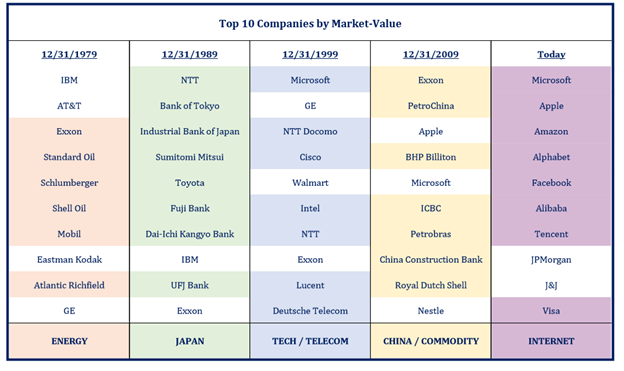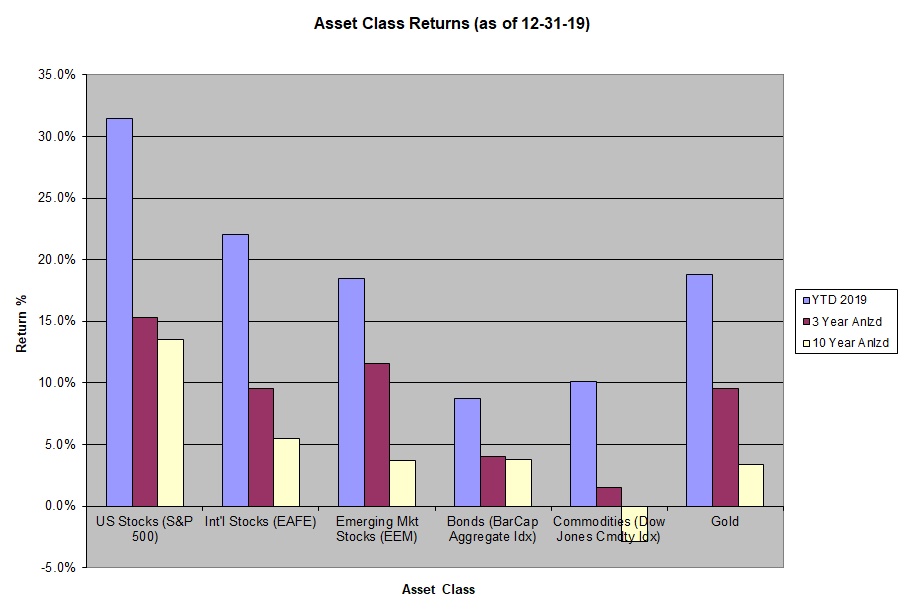AMM First Quarter 2020 Client Letter
A few years ago we attended the Chartered Financial Analyst (CFA) Society’s annual forecast dinner in San Diego. Attendees were a group of mostly professional analysts charged each year with the task of predicting the coming year’s stock market returns and economic growth rates, among other data.
The keynote speaker for the evening, famed investor Howard Marks, noted something interesting. He had a card with the average predictions made at the forecast dinner in prior years, compared with the actual results in the following year. Not surprisingly, those predictions about the future weren’t worth much, as there was absolutely no correlation between the “professional” predictions and the actual outcome. What Marks demonstrated is that analysts and professional prognosticators as a whole do a poor job predicting the future.
However, this wasn’t the interesting part. What caught Marks’ attention about previous predictions is that they did fit very closely with the prior year’s actual returns. Causing him to note, to more than a few chuckles, that “analysts are good at predicting the past.”
There is an important lesson here for investors, since what Marks identified was an example of recency bias in the analyst community. Recency bias is the phenomenon of a person most easily remembering something that has happened recently compared to something that may have occurred awhile back.
Recency bias commonly manifests itself in how investors deal with an uncertain future. We know that predicting the future is impossible, but investing into this kind of uncertainty is uncomfortable. So we make predictions, and those forecasts tend to recall what has happened in the recent past.
The nearby chart (exhibit A) highlights the top ten companies by market value at the end of the last 5 decades. Aside from a few notable exceptions (Exxon made the top 10 for 4 straight decades, Microsoft for the last 3), most companies that make the list do not repeat as a top ten company in future decades. Perhaps more interestingly is how the underlying investment trends evolve over time. What are the odds that the most valuable companies list will be the same 10 years from now? Or that the major investment theme of the last 10 years (Internet) will persist for the next 10?
Exhibit A
2010s Perpetual Panic
A hallmark of the last decade has been the state of near perpetual panic among investors. Sitting here in early 2020, near all-time market highs, it might be easy to forget all of the panic inducing headlines and events that occurred over the last decade. Economist Ed Yardeni, and his team at Yardeni associates counted no less than 65 market panics over the last 10 years! They define a panic as a “relatively short-lived market sell off, of around 5% to less than 20% in the S&P 500.” Among the 65 panics were big ones like the Greek Debt crisis in 2010 (S&P – 15%) to less dramatic affairs like the Brexit “crisis” in 2017 (S&P – 5%).
We suspect that the decade of perpetual panic could have its roots in the recency bias that affected market participants following the great recession of 2008/09. In the years immediately following the great recession, we recall every panic being met with bold proclamations that this was the beginning of a new bear market. The memory of the prior decade’s downturn, in which the S&P annualized at ~ -1%, was so recent and so fresh that predictions of more doom and gloom seemed to be both rational and informed.
But something funny happened among all of this gloom. The domestic stock market (S&P 500) had one of its best decades in history, with annualized returns of 13%. Fear and panic actually meant that investors were not complacent, and that the market had effectively priced in known risks. This is a good thing. It’s only bad if investors let the fear drive them completely out of the market, or worse, in and out like a yo yo. Reacting to every piece of bad news by punching the sell button, and then buying back later at higher prices. Perhaps there is nothing to fear but the absence of fear.
The reality is that at some point a panic will lead to a bear market. But trying to predict when or how this will happen has proven to be a fool’s errand, and has been generally hazardous to long-term portfolio returns over the last decade. Instead of trying to outsmart the market or make uncertain predictions about the next five or ten years, we remain focused on understanding today, and investing according to our 5 core investment principles.
AMMs Core Principles Revisited
Asset Allocation is the Most Important Decision: The decision of how much of your portfolio to invest in stocks, bonds, real estate, and other asset classes is the primary factor in both the long-term return and level of fluctuation in your portfolio. More stock generally equals greater long-term returns but higher volatility vs a more bond heavy portfolio. Determining the appropriate allocation for your unique time horizon, tolerance for volatility and portfolio objectives is the critical first step in managing your portfolio.
Volatility is Not Risk: Real risk is the likelihood of a permanent capital impairment. This is our biggest concern when investing client money. Volatility or the second to second fluctuation of your account is not the truest definition of risk. Volatility is only “risky” to the degree that it causes investors to make decisions that cause permanent capital impairment. The real risk of volatility is that it spooks investors to abandon a well thought out investment policy and sell out of a fundamentally sound position at a loss.
The Price you Pay Determines your Return: In investing, it is really as simple as that. Pay too high a price for any investment, and you will earn a sub-par return. The corollary being that paying a low price shall equate to earning attractive or above average returns. The latter is becoming more difficult as we are ten years in to a bull market and stocks, on average, are trading at above average multiples. However, by focusing on price, we seek to manage risk by only investing at prices that make economic sense in light of our client’s time horizon and objectives.
Time is your Ally but Returns are Not Linear: Patience is a virtue. Investment success tends to come from time in the market, as opposed to timing the market. Predicting when markets will have a good or bad day, week, or year is nearly impossible. Instead, we accept the fact that market returns are choppy and may periodically result in downside. In return for taking on this near-term risk and remaining patient, we seek to benefit from the long-term compounding of returns.
No one can predict the future: Stop forecasting! Investing your portfolio based on some prediction about how the future will unfold is dangerous. In complex systems like the stock and bond markets, the likelihood that you make an error by not fully incorporating all of the potential variables that will affect your prediction is very high. Add to this the probability that even if your prediction is right, it may be wrong for a long-time before it is right. This may lead to a behavioral error of abandoning your otherwise appropriate investment at the wrong time. Married to one outcome/prediction almost ensures failure. Instead, focus on what you can control (principles 1-4).
2019 Review & Current Positioning*
For the year ending 12/31/19, domestic stocks (S&P 500) increased 31%, developed international stocks (EAFE) increased 22%, and emerging market stocks (EM) were up 18%. Bonds (Bar Cap AGG) increased 9%, commodities were up 10% and gold increased 19%. We have updated our asset class return chart (Exhibit B) to reflect YTD 2019 along with three and ten year annualized returns for the aforementioned asset classes.
Exhibit B
By just about any objective measure, 2019 was a phenomenal year for returns across all of the asset classes that we follow. This is in stark departure from 2018 when most assets either lost money or performed poorly relative to their historical averages. Recent strong returns are a double edged sword. On the one hand, making money is naturally a good thing, and strong asset prices are supportive of this endeavor. However the higher asset prices go, the more demanding valuations become and, according to core principal 3, the lower our future return expectations need to be.
In light of current conditions, we continue to invest in assets where we feel the long-term risk/reward tradeoffs are reasonable. In asset allocation portfolios this means continuing to incorporate both developed international stocks and emerging market stocks in client portfolios. While these assets put in strong returns in 2019, over the last decade they have significantly under-performed their domestic counterparts. As such, we think there is catch up potential for these assets, as their valuations are less demanding than those of domestic stocks.
For clients with allocations to bonds, we continue to take a safety first approach. Yields provided on lower quality debt just don’t offer enough return to compensate us for the risks associated with lower quality debt. Instead we are investing primarily in short-term treasury ladders and/or shorter-duration high quality bond funds.
Finally, we are maintaining a modest position in Gold across most asset allocation oriented strategies. Gold showed signs of life in 2019, breaking out to levels not seen in years on continued political and geopolitical drama and uncertainty. We don’t advocate a huge position here, but for diversified portfolios we continue to view gold as a reasonable inflation and uncertainty hedge.
*Individual accounts will vary based on a client’s stated investment objectives, risk tolerance and time frame. We manage several different strategies, so not every client will have exposure to the securities, asset classes or investment strategies described above. In addition to growth and/or income oriented asset allocation strategies, we also manage more concentrated equity portfolios that generally carry a higher degree of risk and volatility. Let us know if you want to discuss your specific portfolio strategy in greater detail.
Should you have any questions regarding your investment account(s) and personal financial plans, or if there have been any recent changes to your investment and/or retirement objectives, please do not hesitate to contact our office to speak with one of us at your convenience. We can also provide you with a current copy of our SEC Form ADV Part 2, at your request.
Finally, if you haven’t accessed our new online client portal, we encourage you to do so. The portal provides a wealth of information about your portfolio strategy, performance and holdings. If you are interested in having access to the portal please contact our office and we will activate your account.
As always, we thank you for entrusting AMM to help you achieve your investment and retirement objectives.
Your Portfolio Management Team





